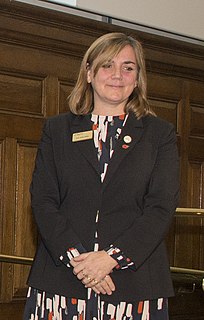The Younger Dryas was a return to glacial conditions after the Late Glacial Interstadial, which temporarily reversed the gradual climatic warming after the Last Glacial Maximum (LGM) started receding around 20,000 BP. It is named after an indicator genus, the alpine-tundra wildflower Dryas octopetala, as its leaves are occasionally abundant in late glacial, often minerogenic-rich sediments, such as the lake sediments of Scandinavia.

Palynology is literally the "study of dust" or of "particles that are strewn". A classic palynologist analyses particulate samples collected from the air, from water, or from deposits including sediments of any age. The condition and identification of those particles, organic and inorganic, give the palynologist clues to the life, environment, and energetic conditions that produced them.
Carolina bays are elliptical to circular depressions concentrated along the Atlantic seaboard within coastal Delaware, Maryland, New York, New Jersey, North Carolina, South Carolina, Virginia, Georgia, and north Florida. In Maryland, they are called Maryland basins. Within the Delmarva Peninsula, they and other coastal ponds are also called Delmarva bays.

Sundaland is a biogeographical region of Southeastern Asia corresponding to a larger landmass that was exposed throughout the last 2.6 million years during periods when sea levels were lower. It includes Java, Borneo and Sumatra and their surrounding small islands, as well as the Malay Peninsula on the Asian mainland.
Tollmann's bolide hypothesis is a hypothesis presented by Austrian paleontologist Edith Kristan-Tollmann and geologist Alexander Tollmann in 1994. The hypothesis postulates that one or several bolides struck the Earth around 7640 ± 200 years BCE, with a much smaller one approximately 3150 ± 200 BCE. The hypothesis tries to explain early Holocene extinctions and possibly legends of the Universal Deluge.

Jack J. Dongarra ForMemRS; is an American University Distinguished Professor of Computer Science in the Electrical Engineering and Computer Science Department at the University of Tennessee. He holds the position of a Distinguished Research Staff member in the Computer Science and Mathematics Division at Oak Ridge National Laboratory, Turing Fellowship in the School of Mathematics at the University of Manchester, and is an adjunct professor in the Computer Science Department at Rice University. He served as a faculty fellow at Texas A&M University's institute for advanced study (2014–2018). Dongarra is the founding director of Innovative Computing Laboratory.

Paleolimnology is a scientific sub-discipline closely related to both limnology and paleoecology. Paleolimnological studies focus on reconstructing the past environments of inland waters using the geologic record, especially with regard to events such as climatic change, eutrophication, acidification, and internal ontogenic processes.
Henri Grissino-Mayer was a tenured faculty member in the department of Geography at the University of Tennessee, Knoxville who resigned in lieu of termination on Oct. 1st, 2018 due to his own admission of sexual misconduct at the school.

The University of Tennessee is a public land-grant research university in Knoxville, Tennessee. Founded in 1794, two years before Tennessee became the 16th state, it is the flagship campus of the University of Tennessee system, with ten undergraduate colleges and eleven graduate colleges. It hosts more than 30,000 students from all 50 states and more than 100 foreign countries. It is classified among "R1: Doctoral Universities – Very high research activity".

The Snowmastodon site, also known as the Ziegler Reservoir fossil site, is the location of an important Ice Age fossil excavation near Snowmass Village, Colorado. Fossils were first discovered on October 14, 2010 during the construction of a 5 hectare reservoir to supply Snowmass Village with water. Over the subsequent weeks, after an agreement had been reached to allow paleontological excavation, crews from the Denver Museum of Nature & Science and the U.S. Geological Survey worked along with the construction crews as more fossil material was uncovered. The site closed for five months over the winter, reopening May 15, 2011. Between May 15 and July 4, 2011, crews from the Denver Museum of Nature & Science conducted a large scale fossil excavation alongside construction crews building a dam for the reservoir. In total over 36,000 vertebrate fossils, more than 100 species of fossil invertebrates and over 100 species of fossil plants were found in sediments deposited by an alpine lake during the last interglacial period.
Jimmy G. Cheek was the chancellor of the University of Tennessee, Knoxville from 2009 to 2017. His experience includes 34 years at the University of Florida, where he was a member of the faculty and an administrator, last serving as senior vice president of agricultural and natural resources. Cheek earned his bachelor's degree and his doctorate from Texas A&M University, and received his master's degree from Lamar University. Cheek is a native of Texas, and he is married to his wife Ileen Cheek and has two children and four grandchildren.
Costa Rican agriculture plays a profound part in the country's gross domestic product (GDP). It makes up about 6.5% of Costa Rica's GDP, and 14% of the labor force. Depending upon location and altitude, many regions differ in agricultural crops and techniques. The main exports include: bananas, pineapples, coffee, sugar, rice, vegetables, tropical fruits, ornamental plants, corn, potatoes and palm oil.
Dr. Margaret Bryan Davis is an American palynologist and paleoecologist, who used pollen data to study the vegetation history of the past 21,000 years. She showed conclusively that temperate- and boreal-forest species migrated at different rates and in different directions while forming a changing mosaic of communities. Early in her career, she challenged the standard methods and prevailing interpretations of the data and fostered rigorous analysis in palynology. As a leading figure in ecology and paleoecology, she served as president of the Ecological Society of America and the American Quaternary Association and as chair of the Department of Ecology, Evolution and Behavior at the University of Minnesota. In 1982 she was elected to the National Academy of Sciences and, in 1993, received the Eminent Ecologist Award from the Ecological Society of America.
Jefferson Chapman is an archaeologist who conducted extensive excavations at sites in eastern Tennessee, recovering evidence that provided the first secure radiocarbon chronology for Early and Middle Archaic period assemblages in Eastern North America. He also is a research professor in anthropology and the Director of the Frank H. McClung Museum at the University of Tennessee, Knoxville. Chapman’s professional interests include Southeastern archaeology, paleoethnobotany, museology and public archaeology.

Katherine Jane Willis is a biologist, who studies the relationship between long-term ecosystem dynamics and environmental change. She is Professor of Biodiversity in the Department of Zoology, University of Oxford, and an adjunct Professor in Biology at the University of Bergen. In 2018 she was elected as Principal of St Edmund Hall, and took up this position from 1 October. She held the Tasso Leventis Chair of Biodiversity at Oxford and was founding Director, now Associate Director, of the Biodiversity Institute Oxford. Willis was Director of Science at the Royal Botanic Gardens, Kew from 2013-2018.

Tham Lod Rockshelter, first researched by Rasmi Shoocongdej from Silpakorn University, funded by the Thai Research Fund, was a prehistoric cemetery and a workshop located in Northern Thailand known to have human inhabitants from the late Pleistocene to the late Holocene period Additionally, Tham Lod is near Ban Rai, another rock shelter and is in the vicinity of two well known caves, Spirit Cave and Tham Lot cave. Recent researches and carbon dating suggested that Homo sapiens have occupied the area. These researches provide more detail on the activities by the humans in the area which includes burials, living habits, gathering, and tool making, and social interactions.

Herbert Edgar Wright Jr was an American Quaternary scientist. He contributed to understanding of landscape history and environmental changes over the past 100,000 years in many parts of the world. He studied arid-region geomorphology and landscape evolution, as well as glacial geology and climate history. The study of these topics led him to the study of vegetation development and environmental history and allowed him to define the timing and mechanisms of climate-driven vegetational shifts in North America during the last 18,000 years and to recognize the role of natural fire in the dynamics of northern coniferous forests. He applied these insights to wilderness conservation and landscape management. He covered many other aspects of paleoecology including lake development and paleolimnology, and the history and development of the vast patterned peatlands of Minnesota and elsewhere in the Northern Hemisphere. Although his work was concentrated in Minnesota, he was also involved in a major synthesis of global paleoclimatology. Beyond Minnesota and the Great Lakes region, Wright studied a wide range of research questions elsewhere in North America, and in the Near East, Europe, Asia, Latin America, and Antarctica. He advised over 75 graduate students and mentored many more students, visitors, and colleagues world-wide.
Cathy Lynn Whitlock is an American Earth Scientist and Professor at Montana State University. She is interested in Quaternary environmental change and palaeoclimatology and was a lead author of the 2017 Montana Climate Assessment. Whitlock has served as President of the American Quaternary Association and was elected to the National Academy of Sciences in 2018.
Margaret Adebisi Sowunmi is a Nigerian botanist and environmental archaeologist. She was Professor of Palynology and Environmental Archaeology at the University of Ibadan. She pioneered the study of environmental archaeology and palaeoethnobotany in Nigeria and is the founder and president of the Palynological Association of Nigeria.

Elizabeth Anna Ainsworth is an American molecular biologist currently employed by the United States Department of Agriculture (USDA) Agricultural Research Service (ARS). She also is an Adjunct Professor of the University of Illinois at Urbana-Champaign (UIUC), a Fellow of the American Association for the Advancement of Science (AAAS) and was awarded the 2018 Crop Science Society of America Presidential Award. She is known for her work concerning the effects of specific atmospheric pollutants, including ozone and carbon dioxide, on the productivity of selected major crops such as corn and soybeans.









